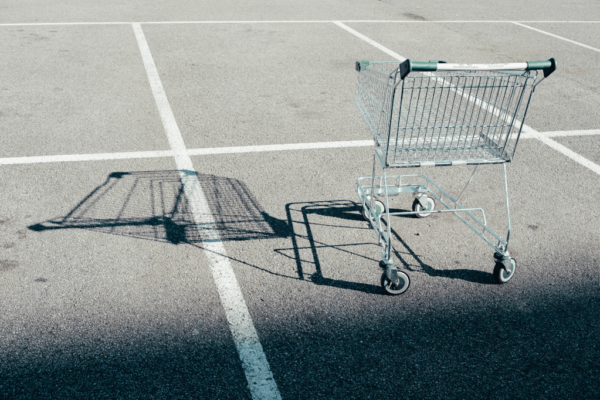
Creating a Winning Abandoned Cart Email
In this Insight we take a deep dive on abandoned cart emails, explaining why they’re effective, and how to design the perfect one for your target audience.
It’s the bane of every ecommerce business: the abandoned cart. You’re so close to making the sale and then for some reason, the customer bounces from the site, leaving their shopping cart unattended. Maybe they get distracted. Maybe they decide to look elsewhere for the product they want. Maybe they second guess their purchase.
Whatever the reason, it’s an incredibly common occurrence. The global average rate of cart abandonment is a whopping 75.6%. This means that roughly three-quarters of the customers that add products to their cart through your site end up leaving without completing their purchase. This number does fluctuate depending on the industry, but it’s safe to say that every ecommerce store deals with a significant amount of cart abandonment.
One of the best ways to recover cart abandoners and improve customer retention is through email marketing. Abandoned cart emails can remind customers of their forgotten carts and motivate them to complete the purchase.
In this post, we’ll be focusing on:
- How and why cart abandonment emails are effective
- How to design a high-impact cart abandonment email
- Testing your variations
How Effective Are Abandoned Cart Emails?
BigCommerce estimated based on recent cart abandonment data that 25% of abandoned carts are influenced by the final price. In other words, it’s not ultimately the price that keeps a person from purchasing.
Rather, customers often use their carts as wishlists of sorts, piling items into the cart that they hope to someday purchase. This is why abandoned cart emails are so effective. They remind the customer that their items are still in the cart, waiting to be purchased.
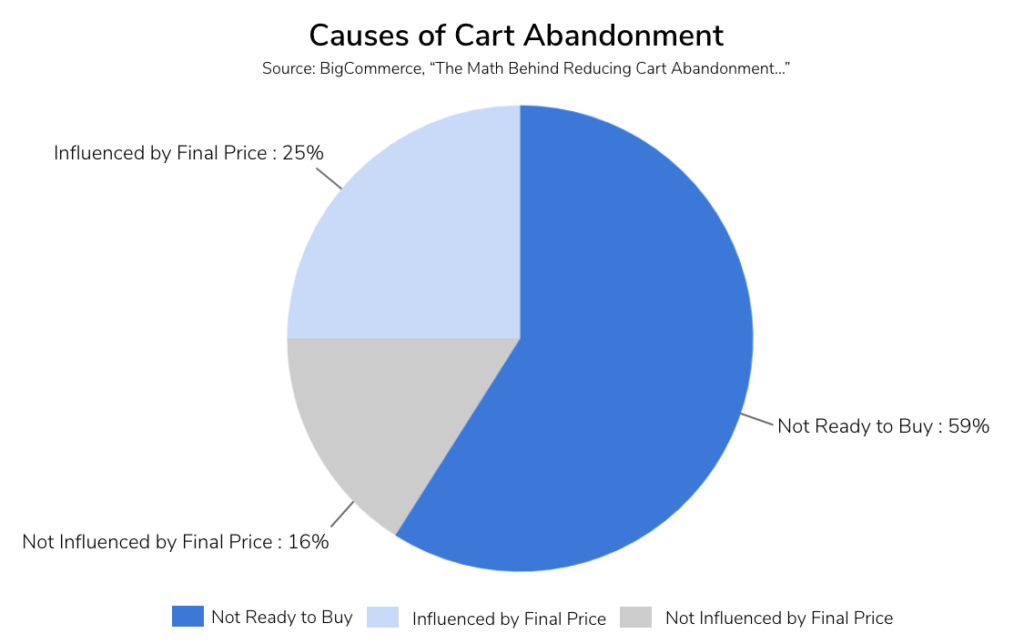
The data backs this up. When it comes to open rates on abandoned cart emails, they hover right around 48%, which is relatively high given that the average open rate for marketing emails is only 17.92%. Clearly, abandoned cart emails are effective, at least when it comes to getting the consumer’s attention.
So what steps should you take when crafting your abandoned cart emails?
Step #1: Consider Your Email Campaign Sequence
Your first abandoned cart email should go out within one hour of the cart being abandoned. This short time window is critical if you want to recapture the interest of the consumer.
75% of all customers who abandon their cart do so with the intent to purchase the same product in the future and 72% of these users intend to buy within the next 48 hours. Sending the first email immediately is critical.
The longer you wait to send out your first email, the more likely the customer is to find the product elsewhere and the less interested in the product they’ll become.
Your first email should focus on the product name, image, and link. The goal should be to reignite their interest in the product, but also create a sense of urgency to push them to complete the purchase on the spot.
This is why it’s so crucial to capture the email address of buyers before the checkout process. If you don’t have an email address in your CRM, there’s no way to follow up on abandoned carts.
Step #2: Consider The Basic Email Marketing Rules
When sending out your abandoned cart emails, follow the basic rules of email marketing:
- Optimizing email subject lines and preview text: Your subject line and preview text are the most valuable real-estate in your entire email. They’re the biggest determinant on whether the customer will open the email or not, so it’s crucial that they’re optimized to catch the customers eye.
Don’t waste your subject line and preview text with surface-level copy like, “You left something in your cart!” Rather, create compelling copy that will motivate the consumer to click the email and view its contents.
Ash Read of Sumo.com recommends using one of six types of subject lines for abandoned cart emails: - Incentivised – Incentivised subject lines offer a bonus if the person finishes their transaction. This bonus could be a percentage off their transaction, free shipping, etc. When using discount codes, just be careful that you don’t cut into your margin too much.
- FOMO (Fear of Missing Out) – Subject lines that create a sense of scarcity and fear of missing out can effectively reduce cart abandonment. This could include a warning that a product may sell out quickly, a limited time discount, etc.
- Personalized – Personalized subject lines can include both the name and the product the person left in their cart. Experian reports that personalized subject lines generate a 12% higher open rate.
- Product-related – Product-related are, to state the somewhat obvious, directly related to the product in their cart. For example, Whisky Loot uses the clever subject line, “Your cart is sobering up.”
- Brand-related – If you have a well-established brand, adding your brand name to the subject line can remind customers why they wanted to purchase in the first place. For example, Dyson is known for creating the best vacuums on the market and they use their name in their subject lines to remind people of that fact.
- The little nudge – Little nudge emails assume that the consumer has already done the research, decided what they want, and added it to the cart. All they need is a little nudge to finish the transaction. Examples of little nudge subject lines would be, “Almost there,” or, “Just one more step!”
- Plain text or HTML emails? There is an ongoing debate about whether plain text or beautifully styled HTML emails perform more effectively for recovering abandoned carts.
Our take on this is that it depends entirely on the industry and market you’re operating in. Typically plain-text emails will get higher open-rates, but that doesn’t mean that an HTML email with heavy image-use won’t have the same effect. It’s up to you to decide which way to go and what you’re customers will respond positively to.
Step #3: Emphasize Scarcity
Customers will respond to scarcity. As mentioned above, they have a distinct fear of missing out (FOMO) when it comes to their product. They fear no longer being able to purchase what they originally wanted.
To create a sense of scarcity, emphasize the limited number of units left or include a countdown if you’re running a particular promotion. Creating this sense of urgency will motivate your customers to take action.

Step #4: Highlight Value-Adds
The more value you can provide to your customers, the more likely they’ll be to come back and complete the purchase. For example, 55% of shoppers abandon carts due to unexpected shipping costs. If you offer free shipping on orders over a certain amount, ensure that your customers are aware of it.
Or, if you’re running a sale on the specific item in their cart, highlight that in your email. Your goal is to give consumers compelling reasons to finish their purchase.
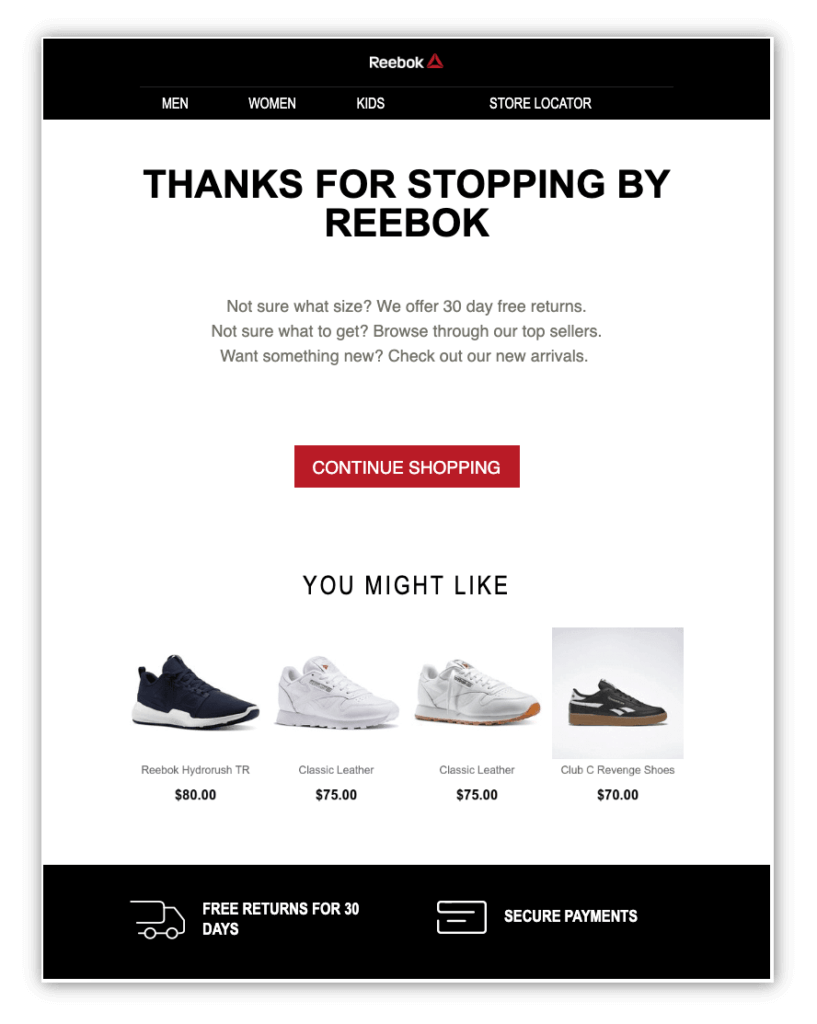
Step #5: Be Personal
The more personal you can make your abandoned cart emails, the more likely it is that customers will complete their purchase. 94% of businesses say that personalization is a key driver to their brand’s current and future success online. Customers clearly respond positively to personalization, so it’s no surprise that it can seriously impact the success of your abandoned cart emails or retargeting campaigns.
Depending on what CRM you’re using, you should be able to include customer-specific details (first name, company, location) in the subject-line and body of your emails. You should also be able to include the specific product that they left in their cart.
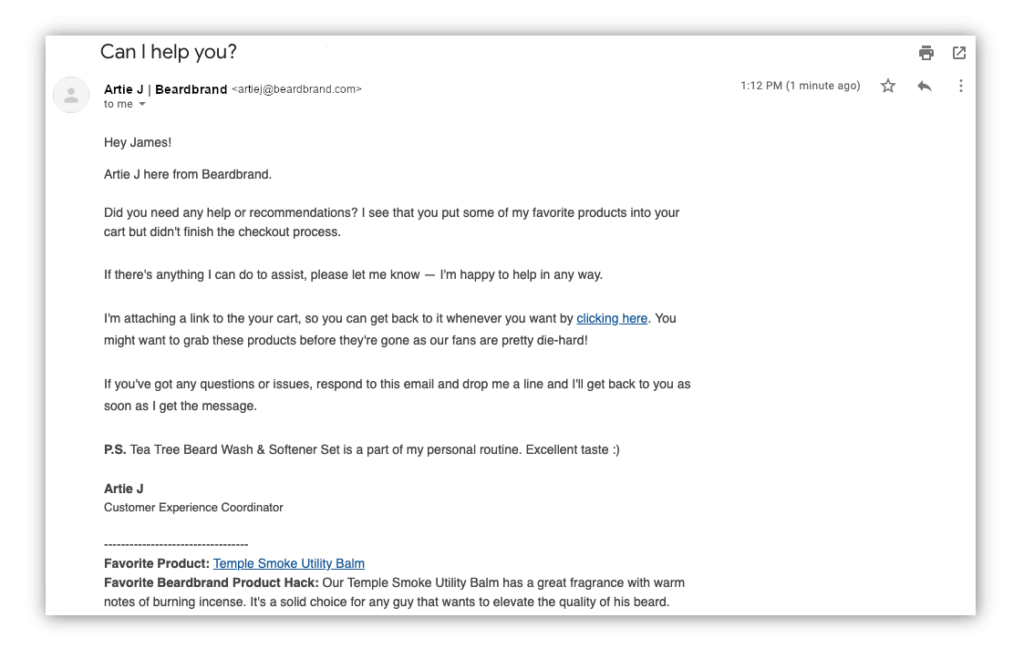
Step #6: Offer A Discount
Normally we don’t recommend offering discounts in an attempt to increase your conversion rates. Discounts eat into your overall profit margin and only temporarily increase your conversion rates. However, when it comes to abandoned carts, discounts can be very effective.
Frame the discount so that customers feel like they’re getting a better deal than what they originally saw when they added the product to their cart. Additionally, emphasize the savings that customers will receive from the discount.
For example, if you offer a discount of 20% to consumers who complete their purchase, highlight the original price compared to the discount price and point out exactly how much a person is saving on their purchase. This has the potential to motivate customers to finish their purchase.
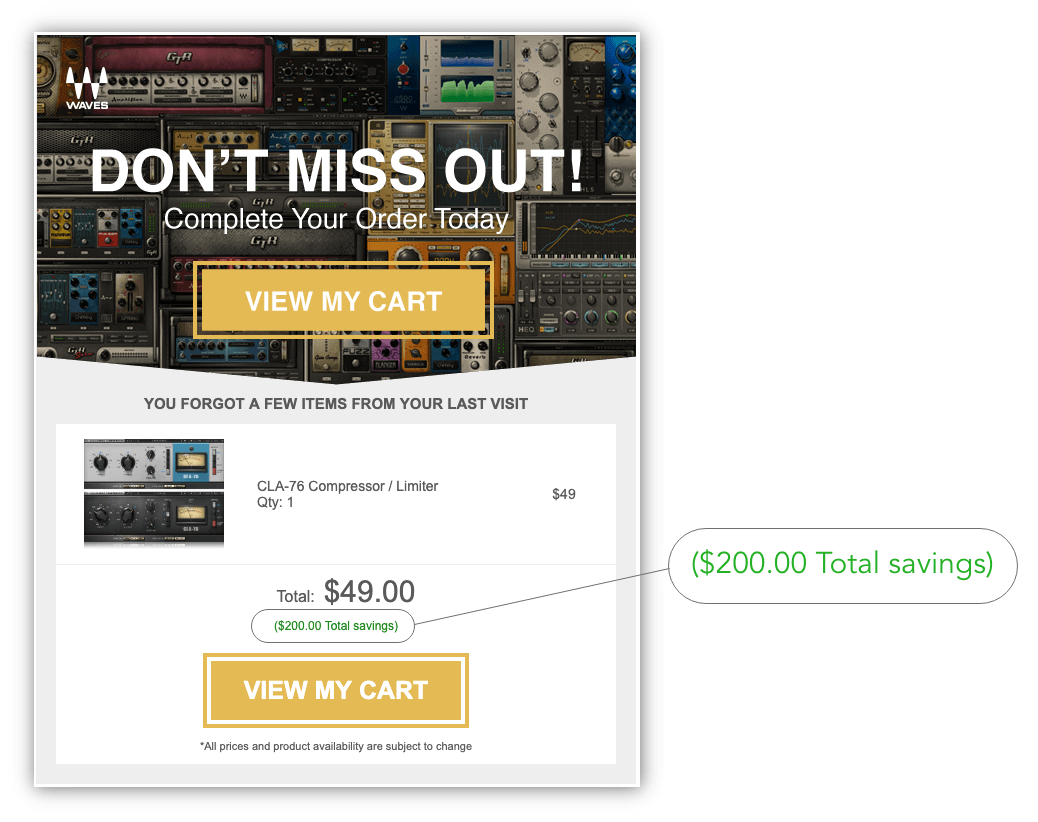
Step #7: Offer Product Recommendations
One reason your customer may have abandoned their cart is because they weren’t able to find the specific product that they were looking for. Maybe they couldn’t find exactly the right color or maybe the dimensions weren’t quite right.
Whatever the reason, offering product recommendations in your abandoned cart emails is a great way to suggest related products that may better suit the needs of your customer.

Step #8: Use Low Commitment CTAs
When sending abandoned cart emails, you want them to be significantly less invasive than standard emails. Don’t use aggressive CTA messaging like, “Buy Now,” or, “Continue Purchase”. This can feel too pushy for the consumer. They don’t want to feel like they’re being forced to complete their purchase. Try and adopt a passive voice when drafting your copy.
A better CTA is something as simple as, “View your cart,” or, “See your items”. Notice that these CTAs aren’t specifically calling the consumer to purchase. Rather, they’re gently nudging the consumer to return to their cart.
When using CTAs, place them as high up as possible in the email, make them clear and large enough to stand out, and repeat them throughout your email.
Step #9: Keep It Simple
As much as possible, keep your abandoned cart emails simple. The more complex and confusing you make them, the more friction it creates for the buyer. Focus their attention on what’s necessary to complete their order.
Keep your emails relatively short and to the point. Point them back to your site and encourage them to make their purchase. Adding much more information has the potential to cut down on your conversion rate.
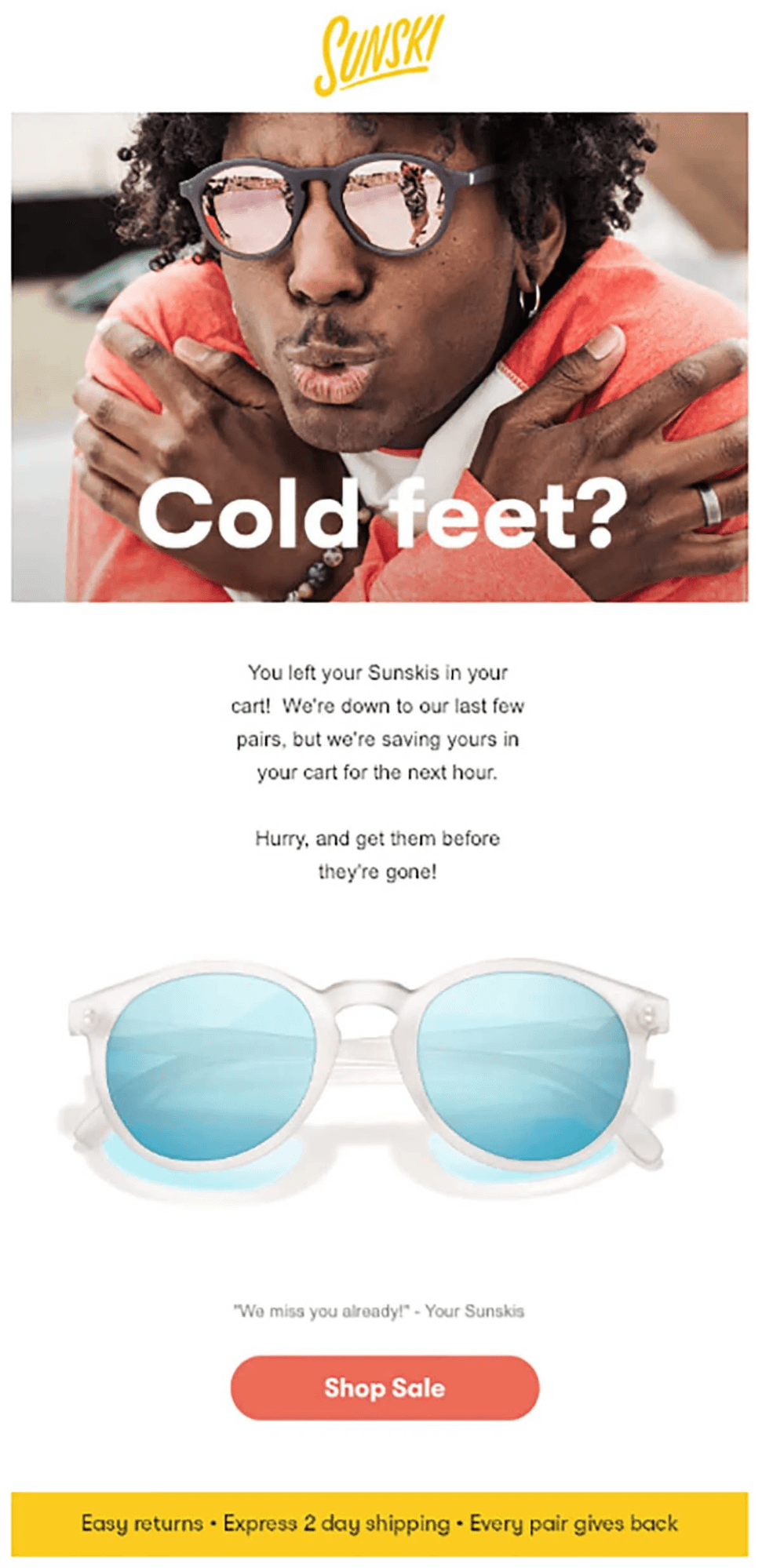
Step #10: Offer Support
Sometimes people have trouble completing the checkout process. Maybe they got confused. Maybe they had trouble with their payment method. Or maybe your checkout process is simply too cumbersome.
Whatever the reason, offering to help complete the purchase can go a long way toward recovering abandoned carts.

Step #11: Present Social Proof
Sometimes people get cold feet when it comes to making a purchase. They abandon their cart because they’re not 100% confident that they’re making the right decision.
In these moments, social proof can be tremendously helpful. Including things like testimonials and reviews can be a highly effective way to overcome people’s objections and hesitations.
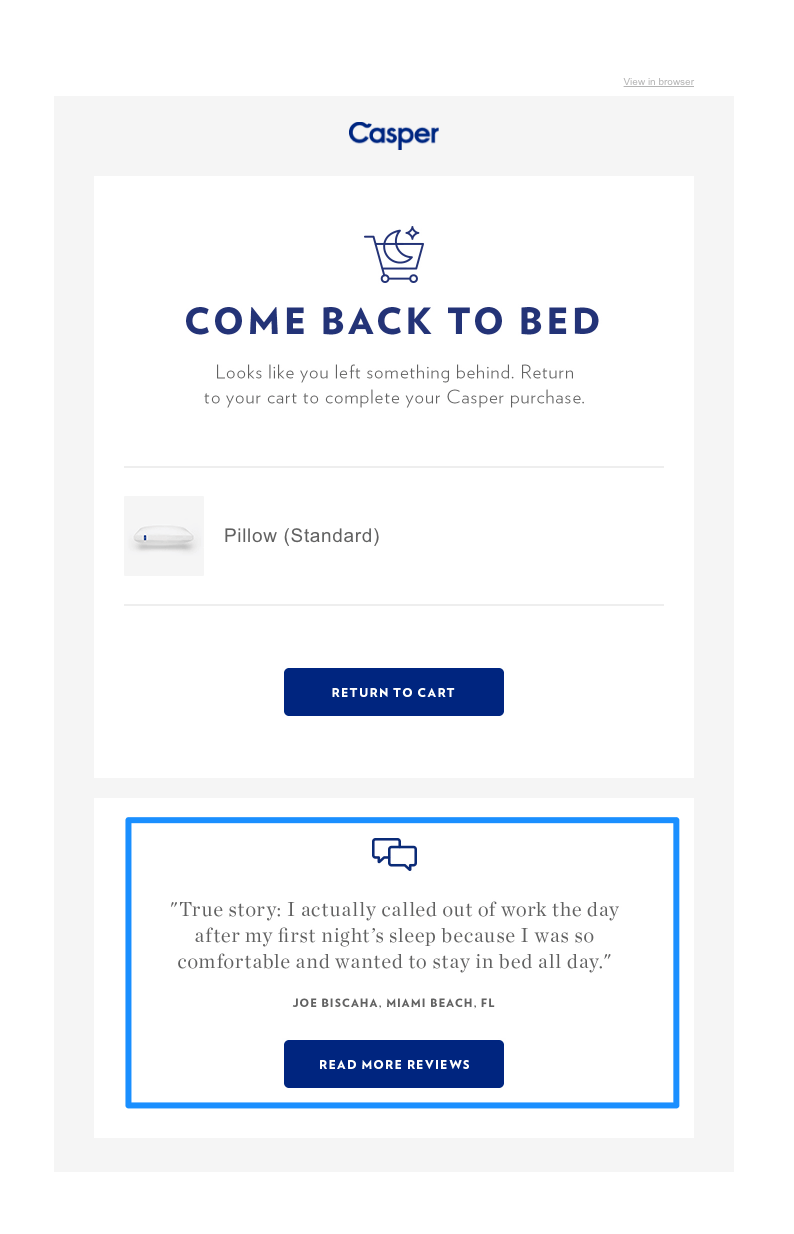
Testing Your Variations
Once you feel like you’ve developed the world’s best abandoned cart email, it’s time to test a few variations on your customers.
The backbone of optimization is experimentation, so it’s crucial to always be testing new designs and copy if you want to get the most impact out of your abandoned cart emails.
Here are a few of the key things you should be testing on your emails:
- Subject line: Try a few different variations of subject lines to determine which one will work the best. Test using the customer’s name in the subject line, including different magnetic words, and possibly even including an emoji or two. You’d be surprised by the impact that a simple tweak to your subject line can mean for your email open rates.
- HTML vs. plain text: Try both of these email styles to see which ones get the best reaction from your customers. Plain text have been known to see better open rates, but that isn’t necessarily true for every business.
- Email sequence: Do you only want to send one cart abandonment email to your customers, or utilize a drip sequence of three emails? Try both of these methods and determine what will work the best for your business.
It’s Time to Crush Cart Abandonment
Every abandoned cart represents lost revenue. And with three out of every four individuals abandoning their carts once they place items in them, that loss can really start to add up. Don’t let your customers get away. Create a powerful abandoned cart email (or sequence of emails) to lure your customers back and compel them to complete their purchase.
Yes, it will require a bit of testing on your end to nail down exactly what works best, but the effort is worth it. The more you can cut down on shopping cart abandonment, the more revenue you’ll add to your bottom line.
Looking for bigger and better ways to improve the conversion rate of your site (beyond just email retargeting)? It could be time for you to consider investing in Conversion Rate Optimization. Request a free landing page assessment where we’ll take a closer look at your site and help you pinpoint where customers may be getting stuck in your UX.

About the Author
Rudy Klobas
Rudy Klobas regularly works to produce insightful, informative content and copywriting designed to help ecommerce leaders increase conversions.